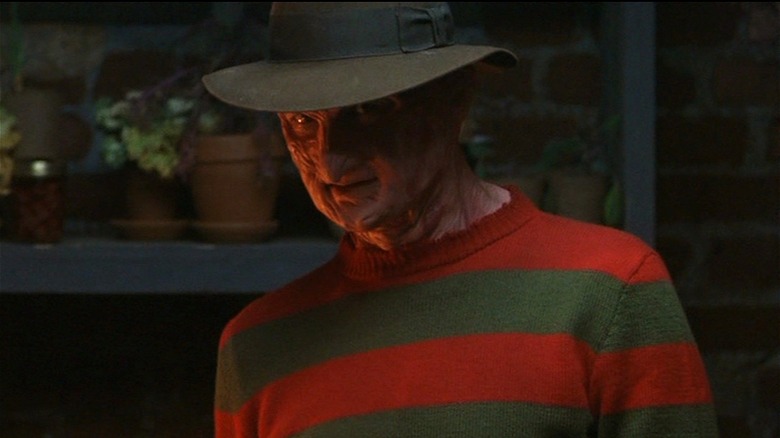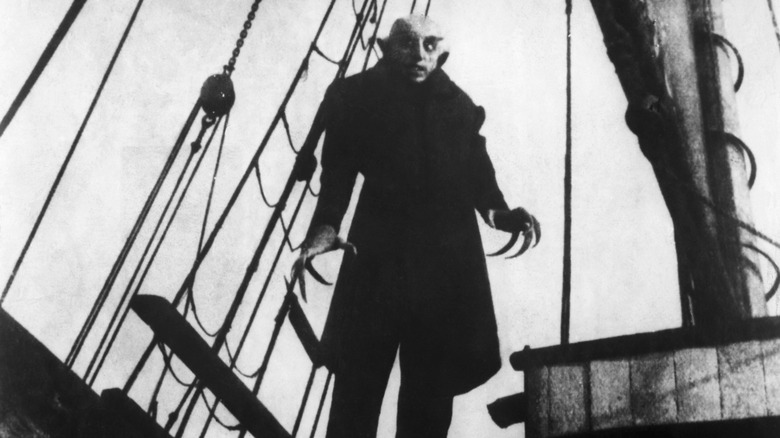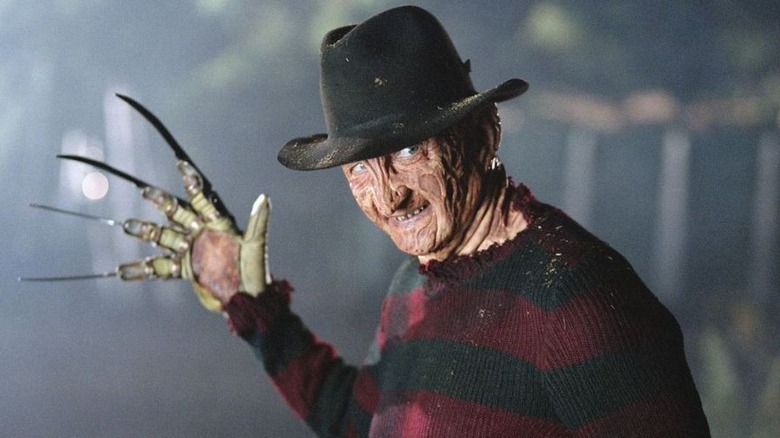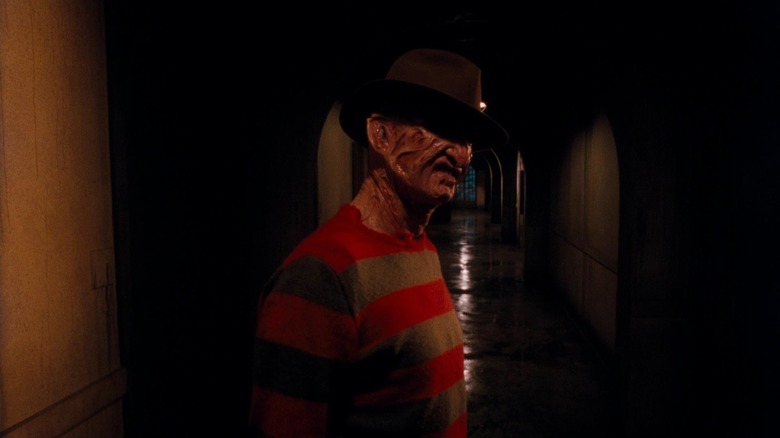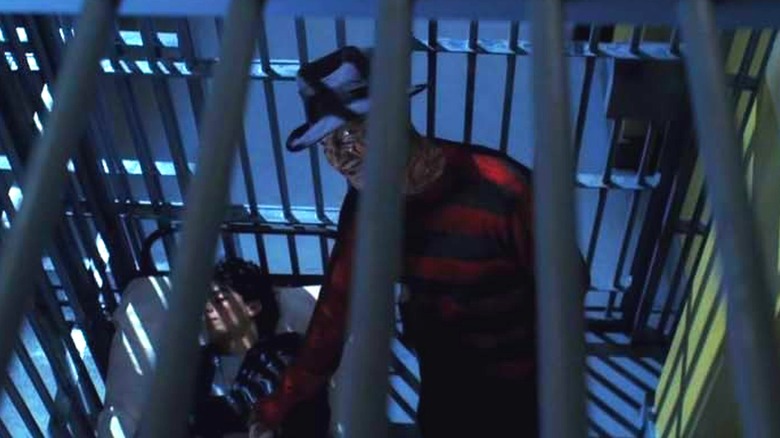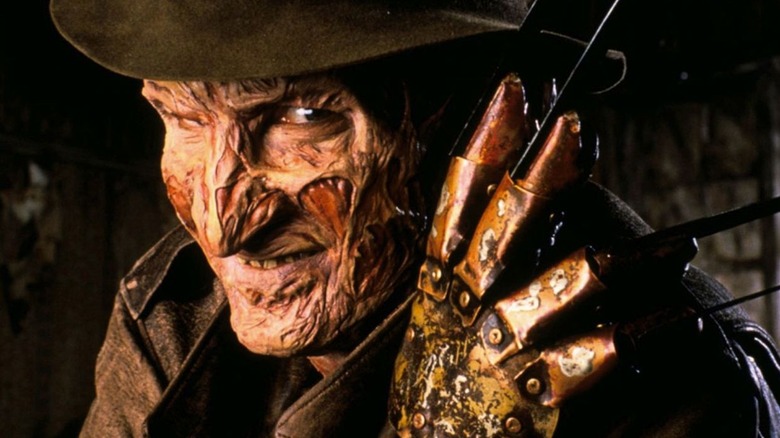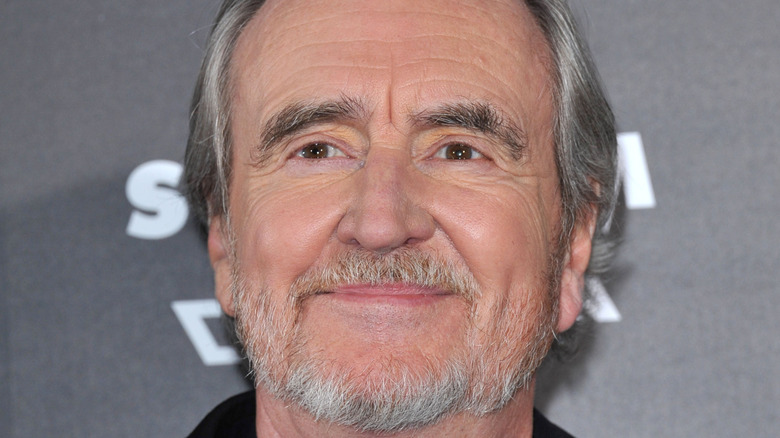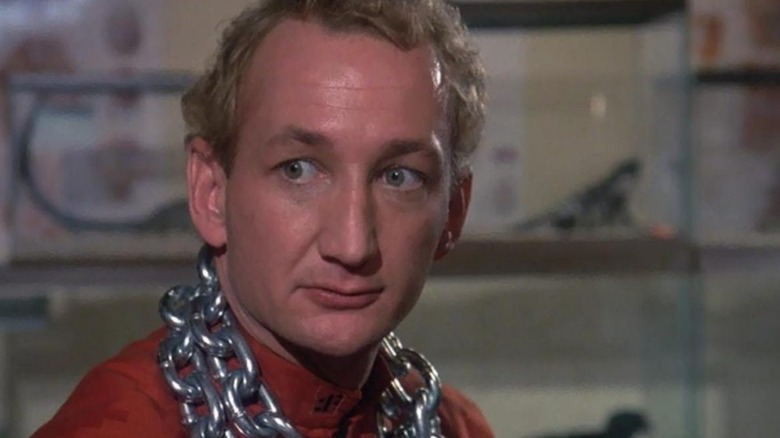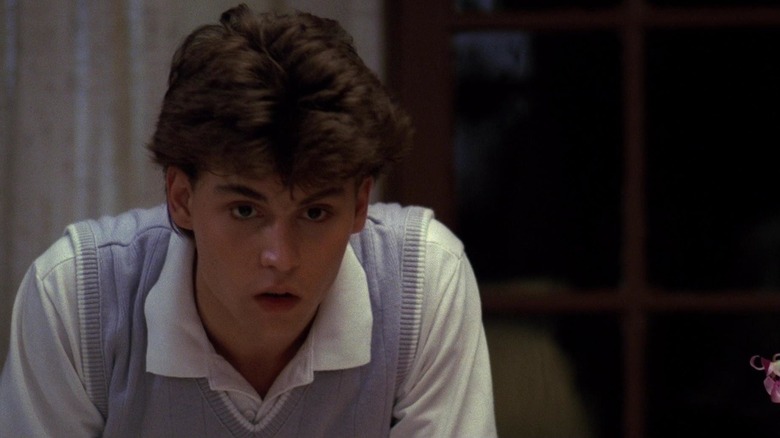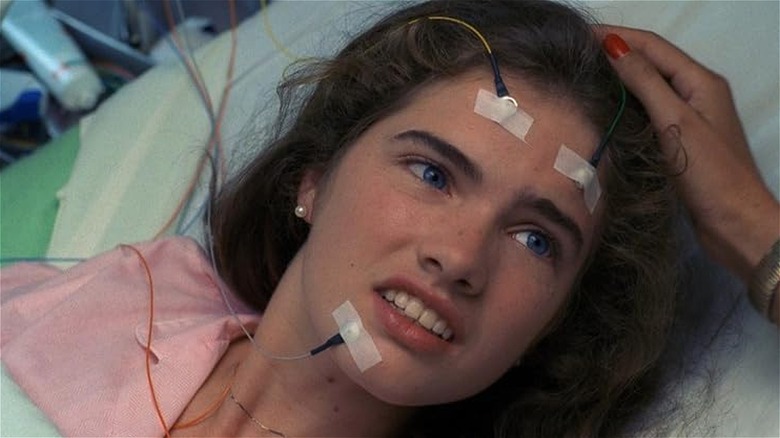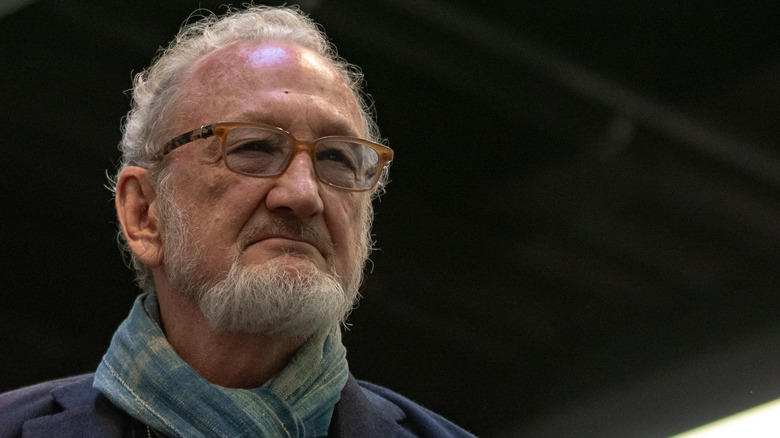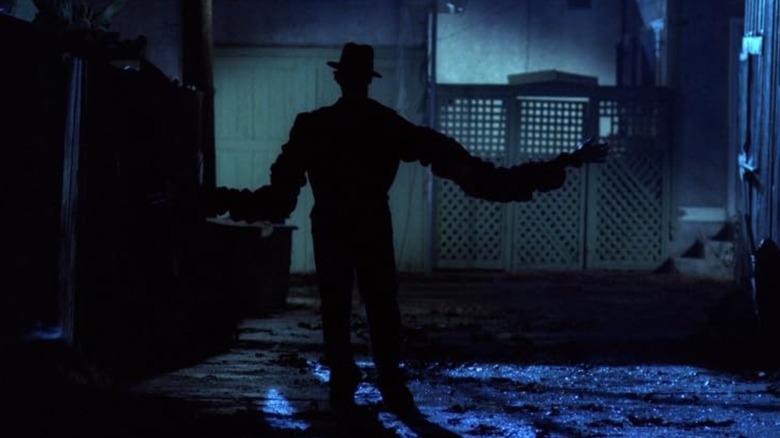The Untold Truth Of Freddy Krueger
In a world of silent-but-deadly slasher movie monsters, one fedora-wearing child killer brought something his creepy colleagues seemed to be lacking: a whole lot of personality. It's frightening enough to be pursued in your sleep by a malevolent spirit with the power to kill you in real life — the fact that Freddy Krueger somehow manages to do it with style only adds insult to injury.
It's hard to overstate the cultural impact of "A Nightmare on Elm Street" villain Freddy Krueger and his maniacal manicure. The character has been parodied or referenced dozens of times, with variations showing up in shows like "The Simpsons," "Rick and Morty," and "South Park." And hearing the tale of Freddy Krueger recounted by his babysitter would one day inspire "Stranger Things" co-creator Matt Duffer to create equally frightening nightmare monster Vecna.
Sure, Freddy could kill you in your sleep, but these days, the iconic striped shirt, hat, and claw hand have become so ubiquitous at Halloween that it's not uncommon to see a young child or even a dog dressed in Freddy regalia. Because we're not sleeping anyway, grab your jump rope and sing your best rhyme as we break down the untold truth of Freddy Krueger.
Robert Englund was inspired by classic monsters
Wes Craven might have dreamed up Freddy, but it took a whole team to bring him to life. The physical process of transforming actor Robert Englund into Freddy Krueger with layers of latex, tubes, and the occasional goat bladder took around three-and-a-half to four hours. Going through that lengthy makeup application process would help Englund get into the headspace to inhabit Freddy. For the psychological side of the maniacal movie monster, Englund drew on classic movie monsters.
The actor grew up in Los Angeles surrounded by the film industry, telling Billy Boyd and Dom Monaghan on their podcast that the sense of old Hollywood was still around during his childhood. As a child, he would accompany his parents to major studio previews where he would see first-run films that are today's classics like "Anatomy of a Murder," "The Guns of Navarone," or "King Solomon's Mines." So it makes sense that Englund looked to the past when developing his own soon-to-be classic character. As Englund told The Guardian, "My Freddy was inspired by Klaus Kinski's 'Nosferatu,' but also by all the monsters that Lon Chaney created."
Freddy's burns are meant to be a type of mask
As Wes Craven began to conceptualize Freddy's look, he knew one thing about famous slasher monsters: They all seem to have some type of mask. For Michael Myers, it's rather famously a mask of William Shatner's face that's been painted white — specifically, according to Shatner, a death mask created for Captain Kirk. In "Friday the 13th," Jason Voorhees hides his soulless face behind a hockey mask, and Leatherface from "The Texas Chain Saw Massacre" wears the face of one of his victims.
According to Cinefantastique, Craven was taken with the ancient, mythological concept of the mask, emphasizing, "Almost all cultures have it in their most important ceremonies. It kind of is a combination of removing humanity and yet leaving it there, behind the eyes." But for Craven, who hoped to imbue his nightmare with a little more personality, the idea of a mask presented a unique problem. As he told Vulture, "I wanted my villain to have a 'mask,' but be able to talk and taunt and threaten." To pull it off, Craven settled on scar tissue from burns that creates a type of mask without obscuring Freddy's ability to emote and express his feelings. It was a stroke of genius that would lead to one of the most iconic villain personalities of all time.
The iconic Freddy shirt was inspired by a Scientific American article
Once Wes Craven had designed Freddy Krueger, he had to dress him, but this also presented a unique problem. For a shapeshifting nightmare spirit, the filmmaker had to come up with something so recognizable that viewers would understand instantly they were looking at Freddy even when he wasn't in his standard form. Craven seemed to instinctively understand something branding experts harp on about today — that the right color scheme can create a look so recognizable audiences automatically associate it with the thing they're meant to.
Speaking to Cinefantastique, Craven said he wanted Freddy's costume to be obvious no matter what form he shape-shifted into and he was inspired by DC Comics' Plastic Man. Although the malleable superhero was prone to shapeshifting, Craven explained "You could always tell it was him because the couch would be red with a green stripe down it ... So I wanted Freddy to be a shape-shifter that could be recognized from his colors." To find the right palette, the filmmaker didn't have to look much further than his coffee table — specifically, a 1982 issue of Scientific American that reported that to the human retina, the most contrasting colors were red and green.
His unique stance is part necessity, part style
Any good character actor will affirm that breathing life into the part they're playing goes far beyond choosing the right accent and voice timbre. There's also a character's motivations, mannerisms, and gait. For Robert Englund, creating Freddy Krueger's unique walk and stance was part creativity, part necessity. For Freddy's posture, Englund drew inspiration from cinema great James Cagney. In an interview with The Guardian, Englund explained that he saw Cagney's wide-legged stance as "a pose that signifies sheer power."
Freddy's shoulder drop, on the other hand, couldn't be helped. According to Englund, the weight of the claw with all of its knives naturally caused his right shoulder to slouch. But instead of fighting it, the actor was more than happy to work it into Freddy's look, saying, "I liked the way it made me look like a cowboy drawing a gun." Put together, the stance and the slouch work to create the lumbering, threatening gait that strikes fear into the hearts of teenagers.
Freddy's glove was inspired by Wes Craven's pet cat
Every good slasher villain has a signature weapon — Leatherface has his chainsaw, Jason has a machete, and Michael Myers uses a kitchen knife. Understanding the importance of the right weapon, Wes Craven wanted to give Freddy one that tapped into his audience's most primal fears. In "Friday the 13th: The Complete Guide," Craven explained that it was his cat that got him thinking about built-in weapon hands. Speaking to Rolling Stone, Craven later explained, "I wanted Freddy's weapon to be something somebody 1,000 years ago could have related to ... predators like cave bears and saber-tooth tigers and all those creatures — if you look at them, they're just knives, hands full of knives." To Craven, that primal fear still lurks in the human subconscious.
The filmmakers played around with the right knives to use, considering fishing knives first before landing on an odd-looking steak knife, which they flipped around and added another sharp edge to create knife-like fingernails. By the end of the production, they had created three iterations of the glove with different scenes and uses in mind: the glove with real blades in it, a glove with Mylar-covered blades to reflect light, and a hard rubber glove for performing stunts. As Englund reflected, "My running joke was I had to be careful going to the bathroom or I could change my religion."
Wes Craven's childhood fright helped formulate the character
One of the oldest maxims in writing is the value of writing what you know. Horror master Stephen King has often written and spoken about the ways he has drawn on his own real-life experience for inspiration. It's a sentiment Wes Craven understands all too well as his own traumatic childhood experience helped fuel his creation of Freddy Krueger.
Fedoras were a popular menswear accessory during Craven's childhood, but one, in particular, left a mark on his young mind. It was that hat that stuck with young Wesley Craven after a frightening encounter with a seriously intoxicated man on the street outside of his home one day. A small child at the time, Craven had been sleeping when the drunk man woke him up through the window. Craven recounted to Cinefantastique, "He just did a mind-[expletive] on me," staring into the young boy's eyes through his window.
Terrified, the child hid in his room for what seemed like forever. When it felt safe again, he crept to the window again only to see the man still standing there before walking away half-backward while continuing to watch him in the direction of his apartment entrance. Although the encounter ended without incident, Craven never let go of the icy cold chill he felt that day, later insisting, "The idea of an adult who was frightening and enjoyed terrifying a child was the origin of Freddy."
Englund's casting was partly a scheduling fluke
After his casting as Freddy Krueger, Robert Englund went on to become a beloved character actor with a penchant for villainy, appearing in more than 75 feature films through the years. It's hard to believe that if not for a fluke of scheduling, Englund's notoriety as an internationally recognizable movie monster might not have happened.
A classically trained actor, Englund auditioned for the part of Luke Skywalker in 1976. After his unsuccessful audition, he came home, drank a six-pack of Heineken, and told his couch-surfing pal Mark Hamill about the gig. While Hamill's career took off as a result, Englund was still struggling to get past being typecast as the nerdy character. In 1983, he landed a more prominent role as the lovable alien resistance fighter Willie on the miniseries "V," ultimately getting promoted to a regular cast member in its sequels and 1984 series.
Englund was happy enough with the success of the series, telling Vulture, "I was on the cusp — or thought I was on the cusp — of celebrity, the result of starring as an adorable curly-haired alien in the miniseries V on NBC." According to Englund, he went in for "A Nightmare on Elm Street" because it was the only audition that fit into his schedule during the hiatus. Impressed with Englund's take on Freddy's darker side, Craven gave him the role, and the rest is history.
Freddy is a metaphor for the loss of innocence as children grow up
For many viewers, horror and slasher films are nothing more than popcorn flicks, and that's totally okay. But for some fans of the genre, taking a deep dive into the subtext of a horror movie is half the fun. Case in point, "The Babadook," which has picked up a cult following for what some fans see as queer subtext. With its surreal horror elements and teenage cast, "A Nightmare on Elm Street" leaves plenty of room for analysis and interpretation — from the view that it represents the struggle between teenage rebellion and parental authority to feminist and queer readings.
Wherever you land in your own analysis of the classic horror film, Wes Craven has his own thoughts about the film's subtext. For the writer-director, "A Nightmare on Elm Street" is about growing up. Speaking to Cinefantastique, he cited the early scene where Nancy's mother puts her to bed. By the end of the film, Craven emphasized, Nancy has gone from being a child to an adult. While intimacy is part of the equation, so is becoming strong and independent enough to face off with Freddy. It's a sentiment echoed in The Guardian by Englund, who reflected, "The character was supposed to signify the loss of innocence, as teenagers turn into adults and become corrupted."
Freddy's dream invasion was inspired by a strange-but-true phenomenon
Internet rumors have long claimed that Freddy was based on a real-world villain from Lamaur Foster's 2017 Facebook viral claim that Freddy hailed from 1800s Ohio to Michael Phariss' 2020 version substituting Oklahoma for Ohio. While these rumors amount to little more than creepypasta, the story itself does draw some inspiration from a ripped-from-the-headines real-life terror. In Vulture's oral history of "A Nightmare on Elm Street," Wes Craven explained the origin of his deadly nightmare tale. The inspiration came from a Los Angeles Times piece about an immigrant family who lost their son under unusually horrifying circumstances.
The family — who had survived Cambodia's Killing Fields under the Khmer Rouge regime — had migrated to the United States to move on with their lives as best they could. But they found this difficult to do when their young son was plagued by terrifying nightmares, ultimately dying in the middle of one. According to Craven, the child believed if he fell asleep, the dream monster would kill him.
"Here was a youngster having a vision of a horror that everyone older was denying. That became the central line of Nightmare on Elm Street," Craven mused. Even more frightening, according to a 1987 Los Angeles Times item, the anomaly wasn't a one-off — it happened so frequently that experts gave it the name "Asian Death Syndrome." The Los Angeles Times claimed that from April 1983 to January 1987, upwards of 130 refugees fleeing Southeast Asia had died from the mysterious condition.
A practical effects mishap nearly fried Robert Englund
While we don't normally think of acting as a treacherous career, on-set accidents can happen — especially when there are complicated special effects involved. Take the ill-fated set of "Rust" or the tragic helicopter accident on the set of "Twilight Zone: The Movie" that took the lives of child actors Myca Dinh Le and Renee Shin-Yi Chen along with veteran actor Vic Morrow.
Fortunately for fans of Robert Englund, things didn't turn out nearly as bad as they could have on the set of "A Nightmare on Elm Street" when filming one crucial scene didn't go as expected. In a tale recounted by several members of the cast and crew to Rolling Stone, Englund surmised the special effects team had been shooting for about four days "on the Eighties equivalent of Red Bull, if you know what I'm talking about" when it came time to film Glen's (played by a 21-year-old Johnny Depp) death. For the bloody scene, they devised a system to shoot out hundreds of gallons of bloody water all over the room very quickly but had overlooked insulation on their electrical components. An effects technician went the wrong way, creating a "two-inch tsunami" of fake blood all over the electrical equipment. Sparks flew, the lights went out, and Englund took off with Heather Langenkamp. "I wasn't about to [expletive] save anybody. I didn't want to get electrocuted."
Freddy became a puppet for that famous arm-stretching scene
Freddy might be one of our favorite villains of all time, but few would want to meet him in a dark alley — even if it means getting to see one of his coolest tricks — as Tina Gray (Amanda Wyss) did just before he killed her. In the infamous death scene, Tina steps into the alley to see Freddy, who stretches out his arms before chasing her around and then finally killing her, with Rod (Jsu Garcia) looking on in horror as she's tossed about the bedroom and gutted from the dream world. As far as slasher death scenes go, it's one of the greats, thanks in large part to some pretty spectacular work on the part of the effects team.
These days, using CGI to create special effects is something of a given. But back in the golden age of slasher films, filmmakers had to get a little more creative — doubly so in a film that deals in the surreal world of nightmares where the laws of physics don't quite apply. To create Freddy's arm extension, the special effects team attached fishing poles to Freddy's extra-long arms, effectively turning him into a giant marionette. To make his knives spark when he touched the wall, a car battery was connected to his glove. And for the scene's final feat, the special effects team used a revolving room like the one Fred Astaire uses to dance across the ceiling in the 1951 musical "Royal Wedding."
